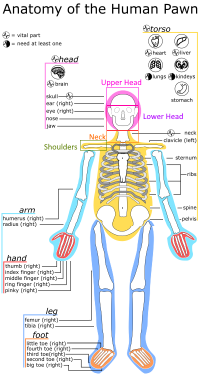Armor
|
Armor is a type of apparel that generally offers good protection from damage, but poor insulation and (in some cases) movement speed penalties.
If left exposed with no roof, armor will deteriorate until it disintegrates. Like clothing, armor also slowly degrades while worn on colonists or when the wearer gets hit.
Colonists wearing armor have a chance of outright avoiding all damage from an attack, as the reinforced plates can sometimes utterly deflect a bullet or a melee strike. This will be represented by a "tink" sound and a spark. They may also receive a mitigated blow, for only half of the damage.
The Gear tab shows aggregate stats about armor once worn, including total protection and mass.
Armor rating
There are several types of armor ratings;
| Name | Label | Description |
|---|---|---|
| Blunt | Armor - Blunt | Protection against blunt damage like club attacks, rock falls, and explosions. |
| Piercing | Armor - Piercing | Protection against piercing damage like bullets, knife stabs, and animal bites. |
| Heat | Armor - Heat | Protection against temperature-related damage like burns. |
Each effective point of armor gives 0.5% to harmlessly deflect damage, and another 0.5% chance to mitigate it, instead receiving half the damage as blunt damage. Each effective armor point below 100% results in a net 0.75% reduction in damage, while each point above results in a 0.25% reduction. This means that at 200% effective armor rating, colonists will be completely immune to damage; this currently works only on heat damage which lacks armor penetration, and can be seen on mechanoids.
Cataphract armor at Legendary quality comes at a close second, reaching 200% sharp rating, though all sharp attacks have armor penetration meaning that even a pawn hit too many times will fall.
In-game this is calculated as follows:
- The armor rating is reduced by the armor penetration value, dependent on the weapon.
- The remaining armor rating is then compared against a random number from 0 to 100:
- If the random number is under half the armor rating, the damage deflects harmlessly.
- If the random number is over half the armor rating, but not higher than the armor rating, the damage is mitigated.
- If the random number is greater than the armor rating, the armor has no effect.
- Maximum armor rating is at 200%.
Armor is calculated per piece of apparel, from the outside in. Armor mitigation does stack multiplicatively, e.g. 2 pieces of clothing or armor will mitigate damage twice for 25% damage.
Note that armor does not stop weapons with sufficient stopping power from staggering colonists, even if the damage is deflected.
Durability
Apparel, including armor, take damage over time and when it gets hit and blocks damage for the wearer. It takes a constant fraction of incoming damage instead of absorbing all prevented damage, so high-quality armor lasts about the same time as low-quality armor.
Clothing Layers
Each item of apparel or utility gear is worn on a specific location of the wearer's body. That location is determined by two things:
- The body part groups it covers.
- The layer or layers it occupies.
Apparel combinations are limited by layer and coverage - an item cannot be worn with another item that covers the same body parts and on the same layer. Thus, items covering the same parts but on different layers are compatible, as are items on the same layer but with no overlap in coverage. Items that cover multiple layers conflict with items on all layers.
Layers are also used to determine the order in which armor calculations are performed, with the outermost layer's armor applying first, and progressing through the layers until the attack is stopped or there are no more layers.
The layers, from innermost to outermost, are:
- Skin: The closest layer to the body, and mostly used for apparel below the head.
- Middle: The second closest layer to the body, and mostly used for apparel below the head.
- Outer: The third layer from the body, and mostly used for apparel below the head. Note that it will be displayed on the pawn's sprite above all other layers, even though it is considered below the following layers for actual mechanical effects.
- Belt: Technically the fourth layer. A distinct layer for utility items to allow them to be worn alongside any other apparel but not with each other.
- Headgear: The fifth layer, and used for headwear. There are several items that cover body parts typically covered by the other layers however, in which case this will be above them.
- Eyes: The outermost layer. A distinct layer only used for the blindfold
 to allow it to be worn alongside headwear.
to allow it to be worn alongside headwear.
Which body parts currently have items that occupy each of the layers is shown in the table on the below; layers and body parts which are not currently used by gear were omitted. As such, the hands and feet which are not covered by any apparel or any layer, are omitted.
Examples
- You can't wear pants as well as tribalwear, since both cover the "skin" layer and cover the legs.
- You can wear pants and a button-down shirt, since while they both use the "skin" layer they don't cover the same parts.
- You can wear pants and a duster, since while they both cover the legs pants use the "skin" layer while a duster uses the "outer" layer.
Middle Layer
Flak vest
Middle and On skin layer
Flak pants
Middle and Outer Layers
Plate armor
Very heavy armor. Not advised for 24/7 wearing on colonists due to the significant -0.8c/s movement speed penalty.
Flak jacket
Decent protection with only a small -0.12c/s movement speed penalty. Strictly worse than a devilstrand duster though.
Recon armor
Better protection than plate armor or a duster and only a -0.12c/s movement speed penalty.
Marine armor
Armor like this is often used by rapid-incursion space marines.
Durable but heavy armor. Not advised for 24/7 wearing on colonists due to the -0.4c/s movement speed penalty.
Cataphract armor
The strongest armor in game. Not advised for 24/7 wearing on colonists due to the -0.4c/s movement speed penalty.
Headgear
Simple helmet
Cheap, but bulky protection for one's noggin. Can be made out of various materials to potentially improve durability and therefore lifetime. Less protective than a Flak Helmet.
Flak helmet
Mid-tier headgear that provides better protection than the simple helmet. Companion to the Flak vest.
Recon helmet
Marine helmet
Advanced, but uncomfortable. It is currently the only helmet that covers the entire face.
Cataphract helmet
Psychic foil helmet
Great protection against mind-reading lizard men. Not so great at stopping bullets.
Psyfocus helmet
Waist Layer
Shield belt
A shield belt is most effective for melee combatants to allow them to close ground on a ranged attacker with little risk of taking weapons fire. Shields block attacks from Spike traps as if they were ranged attacks.
Smokepop belt
Once hit, releases a cloud which reduces the hit chance of any projectile passing through it by 70%. Affects friend and foe. Does not affect melee.
Version History
In Beta 18 or earlier each point of armor from 1 - 50% reduced damage by 1%, each point of armor between 51 - 100% provided a 1% chance to not take damage, each point of armor beyond 100% reduced damage by 0.25% and gives a 0.25% chance to not take damage. Total protection capped at 90% damage reduction and 90% deflect chance (i.e. 260% armor rating).
















